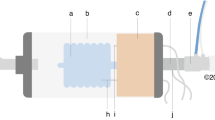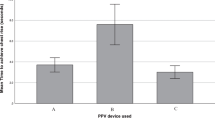Abstract
Objective
To assess tidal volume (Vt) and minute ventilation (MV) during cardiopulmonary resuscitation (CPR) with two different chest compressions techniques: two-finger (TFT) or two-thumb technique (TTT) in a neonatal model.
Methods
Vt and MV were continuously measured during consecutive periods of resuscitation in an intubated manikin. Thirty participants performed the two compression techniques in a random order for 2-min periods while performing positive pressure ventilation using a T-piece resuscitator (TPR) or a self-inflating bag (SIB).
Results
Vt during CPR with TFT was significantly higher than TTT with either TPR: 44.9 ± 4.3 vs 39.2 ± 5.4 ml (p < 0.001) or SIB: 39.2 ± 5.7 vs 35.6 ± 6.5 ml (p < 0.023). Similarly MV was significantly higher in TFT than TTT with either mode: 1346 ± 130 vs 1175 ± 162 ml/min, respectively, with TPR (p < 0.001) and 1177 ± 170 vs 1069 ± 196 ml/min with SIB (p < 0.03).
Conclusions
Chest compressions during CPR using the TFT achieved higher Vt and MV than TTT in this model of neonatal resuscitation.

Similar content being viewed by others
References
Wyckoff MH, Aziz K, Escobedo MB, Kapadia VS, Kattwinkel J, Perlman JM, et al. Part 13: neonatal resuscitation 2015 American heart association guidelines update for cardiopulmonary resuscitation and emergency cardiovascular care (reprint). Pediatrics. 2015;136:S196–218. https://doi.org/10.1542/peds.2015-3373G.
Perlman JM, Wyllie JP, Kattwinkel J, Wyckoff MH, Aziz K, Guinsburg R, et al. Part 7: neonatal resuscitation: 2015 international consensus on cardiopulmonary resuscitation and emergency cardiovascular care science with treatment recommendations. Pediatrics. 2015;136:S204–41. https://doi.org/10.1542/peds.2015-3373D.
Menegazzi JJ, Auble TE, Nicklas KA, Hosack GM, Rack L, Goode JS. Two-thumb versus two-finger chest compression during CPR in a swine infant model of cardiac arrest. Ann Emerg Med. 1993;22:240–3.
Christman C, Hemway RJ, Wyckoff MH, Perlman JM. The two-thumb is superior to the two-finger method for administering chest compressions in a manikin model of neonatal resuscitation. Arch Dis Child Fetal Neonatal Ed. 2011;96:F99–101.
Saini SS, Gupta N, Kumar P, Bhalla AK, Kaur H. A comparison of two-fingers technique and two-thumbs encircling hands technique of chest compression in neonates. J Perinatol. 2012;32:690–4.
Millin MG, Bogumil D, Fishe JN, Burke RV. Comparing the two-finger versus two-thumb technique for single person infant CPR: a systematic review and meta-analysis. Resuscitation. 2020;148:161–72.
Martin PS, Kemp AM, Theobald PS, Maguire SA, Jones MD. Does a more “physiological” infant manikin design effect chest compression quality and create a potential for thoracic over-compression during simulated infant CPR? Resuscitation. 2013;84:666–71.
Jo CH, Jung HS, Cho GC, Oh YJ. Over-the-head two-thumb encircling technique as an alternative to the two-finger technique in the in-hospital infant cardiac arrest setting: a randomised crossover simulation study. Emerg Med J. 2015;32:703–7.
Solevag AL, Madland JM, Gjaerum E, Nakstad B. Minute ventilation at different compression to ventilation ratios different ventilation rates and continuous chest compressions with asynchronous ventilation in a newborn manikin. Scand J Trauma Resusc Emerg Med. 2012;20:73.
Li ES, Cheung PY, O’Reilly M, Schmölzer GM. Change in tidal volume during cardiopulmonary resuscitation in newborn piglets. Arch Dis Child Fetal Neonatal Ed. 2015;100:F530–3.
Yannopoulos D, McKnite S, Aufderheide TP, Sigurdsson G, Pirrallo RG, Benditt D, et al. Effects of incomplete chest wall decompression during cardiopulmonary resuscitation on coronary and cerebral perfusion pressures in a porcine model of cardiac arrest. Resuscitation. 2005;64:363–72.
Lee SY, Hong JY, Oh JH, Son SH. The superiority of the two-thumb over the two-finger technique for single-rescuer infant cardiopulmonary resuscitation. Eur J Emerg Med. 2018;25:372–6.
Udassi S, Udassi JP, Lamb MA, Theriaque DW, Shuster JJ, Zaritsky A, et al. Two-thumb technique is superior to two-finger technique during lone rescuer infant manikin CPR. Resuscitation. 2010;81:712–7.
Acknowledgements
We are grateful to Edgardo Szyld MD for his critical review of this manuscript and for the valuable help of all participants.
Author information
Authors and Affiliations
Corresponding author
Ethics declarations
Conflict of interest
The authors declare no competing interests.
Additional information
Publisher’s note Springer Nature remains neutral with regard to jurisdictional claims in published maps and institutional affiliations.
Rights and permissions
About this article
Cite this article
Jahnsen, J., González, A., Fabres, J. et al. Effect of two different chest compression techniques on ventilation during neonatal resuscitation. J Perinatol 41, 1571–1574 (2021). https://doi.org/10.1038/s41372-021-01061-2
Received:
Revised:
Accepted:
Published:
Issue Date:
DOI: https://doi.org/10.1038/s41372-021-01061-2
- Springer Nature America, Inc.




